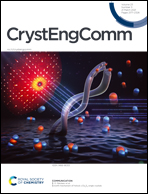A new Zn(ii) MOF assembled from metal–organic cubes (MOCs) as a highly efficient adsorbent for cationic dyes†
Abstract
The process of assembling astutely designed well-defined metal–organic cubes (MOCs) is attracting considerable attention due to their rare networks and topologies. A novel 3D self-assembly directed by MOC (1), [Zn3(Tz)2(tpa)2(DMSO)4], has been synthesized, which, from crystallography and ToposPro, is defined as a binodal (3,4)-connected moc network with the [4.82] Schläfli symbol, and a net that contains alternate 3-connected Tz nodes and 4-connected Zn nodes. The cluster representation reveals an interwoven pcu 6/4/c1 sqc1 topological type. The present metal–organic framework (MOF) exhibits excellent water stability and therefore has been exploited for the adsorption and separation of selected toxic cationic dyes, namely methylene blue (MB) and rhodamine B (RB), and the anionic dye methyl orange (MO). The adsorption efficiency of the designed Zn(II) MOF (adsorbent) was determined at equilibrium, neutral pH, and room temperature to be 82.43% for MB, which is amongst the highest values calculated for MOF systems. For RB, the removal percentage recorded was 71.35%. The anionic dye (MO) showed negligible adsorption. The adsorption capacities (qe) of MOC 1 towards MB and RB were calculated to be 112.11 mg and 90.90 mg per gram of 1, respectively. The governing factors are cation⋯π and π⋯π contacts which consolidate the interactions between the dye molecules and the adsorbent material. Strong electrostatic interactions are observed between the cationic dye MB(+)/RB(+) and the negatively charged ring of the linker, which lead to the adsorption of dye molecules onto the surface of the adsorbent. On the other hand, the anionic dye (MO) faces strong electrostatic repulsion due to its anionic nature and the negatively charged ring of the linker, which explains its lack of adsorption on the adsorbent. Moreover, the MOF shows good recyclability, i.e., it can be reused up to five times without loss of efficiency. A pseudo-second order kinetics model shows a favourable fit for the adsorption of the dyes. Hence, the designed Zn(II) framework with MOC building blocks opens up new opportunities for utilizing the little-exploited chemistry of MOCs towards dye adsorption, and it establishes a structure–activity relationship that can be tuned to enhance the separation of organic pollutants from mixtures in waste water.

- This article is part of the themed collection: Coordination Networks


 Please wait while we load your content...
Please wait while we load your content...